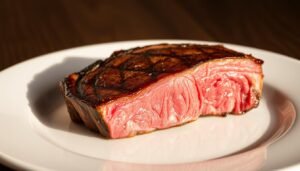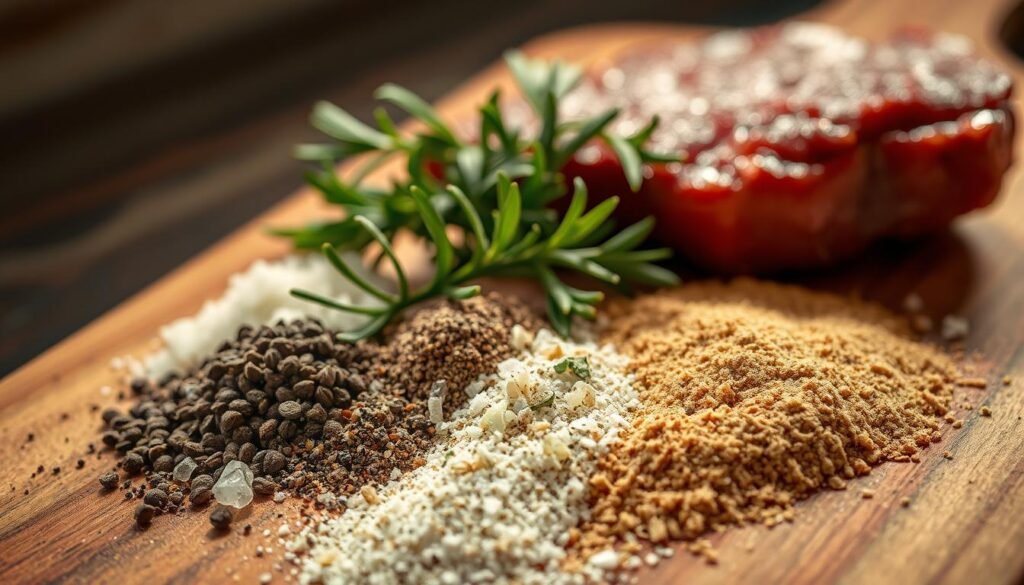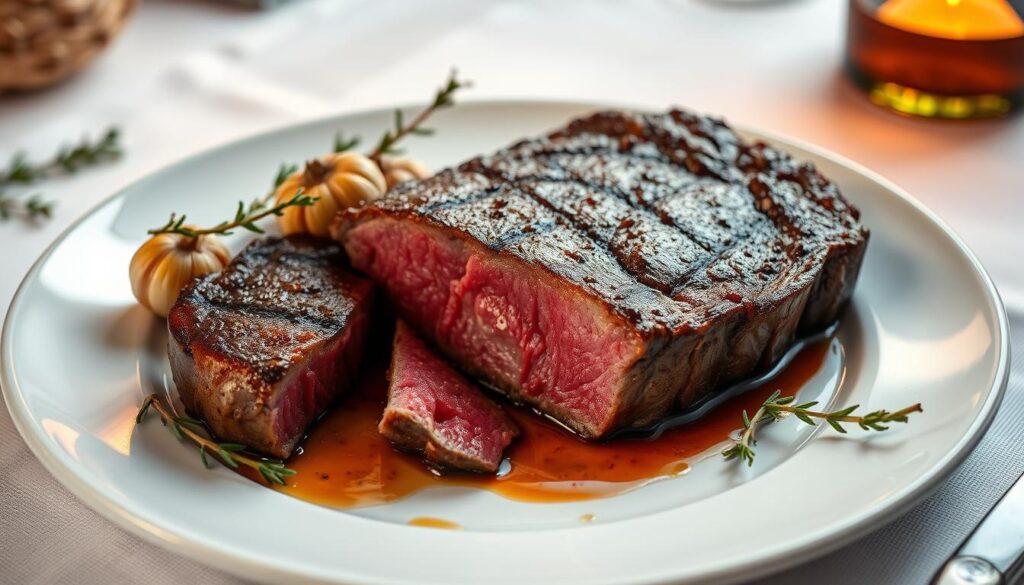The Best Fluffy Pancakes recipe you will fall in love with. Full of tips and tricks to help you make the best pancakes.

Imagine biting into a perfectly cooked ribeye steak. The tender meat and rich flavors are a delight. Cooking a ribeye steak is an art that needs attention to detail. This guide will show you how to pick, season, and cook the best ribeye steak.
Cooking a ribeye steak is easy and rewarding. It’s faster than waiting for a table at a restaurant. To get it right, you need to know about grilling temperature, searing time, and internal temperature. This guide will give you the tips and techniques to make a juicy and flavorful ribeye steak.
Table of Contents
Understanding the Ribeye Steak Cut
When cooking a juicy ribeye steak, knowing the meat cut is key. The ribeye comes from a cow’s rotational muscle. It’s known for being tender and flavorful. The fat spread throughout the meat makes it taste rich and juicy.
A ribeye steak recipe often uses a ribeye steak marinade to boost flavor. The fat in the steak holds onto marinade and seasonings well. This makes ribeye a favorite among steak fans. To make a great ribeye steak recipe, knowing the cut’s anatomy is crucial.
Anatomy of a Ribeye
The ribeye cap, or Spinalis Dorsi, is very marbled and flavorful. The eye of the ribeye, or Longissimus Dorsi, is leaner but still tender and tasty. Knowing the ribeye’s parts helps in making a better ribeye steak recipe.
Marbling and Its Importance
The marbling in a ribeye steak makes it unique. The fat content, classified as non-lean, adds a rich, buttery taste. More marbling means a higher-grade steak, which is more tender and flavorful.
Different Grades of Ribeye
The ribeye steak’s grade depends on marbling, tenderness, and flavor. A higher-grade steak has more marbling, making it more tender and tasty. When picking a ribeye, choose one with good marbling and tenderness.
Selecting the Perfect Ribeye Steak at the Butcher
Choosing the right ribeye, or steak is key. You want it to taste great and fit your cooking style, like grilling. A thicker steak is better for grilling because it cooks evenly.
For a prime ribeye, steak, aim for a thickness of 1.5 inches. This ensures it sears well and cooks indirectly.
What you like matters a lot when picking a steak. Butchers say knowing your taste preferences is crucial. Do you prefer a bone-in or boneless steak? Do you like it fatty or lean?
The steak you choose should match your cooking method and how you plan to prepare it. For example, if you’re using ribeye, steak seasoning, pick a steak with good marbling and tenderness.
Some top steak cuts include the Bavette for a rich flavor and the Shoulder strip for a lean, sweet taste. Talking to butchers about what you like can help you pick the best steak. This way, you can get a steak that’s perfect for grilling or pan-searing.
Understanding your own taste and cooking goals is the secret to finding the perfect ribeye steak. By thinking about thickness, marbling, and cutting, you’ll find a steak that’s sure to impress. Enjoy a great ribeye steak grill or ribeye steak seasoning experience.
Essential Tools for Cooking Ribeye Steak
To cook a delicious ribeye, steak, you need the right tools and equipment. A good quality skillet or grill is key. A heavy-bottomed skillet or cast iron pan is best for even heat and searing.
This helps avoid hot spots and ensures a juicy steak. For a ribeye steak recipe, a meat thermometer is crucial. It helps you cook the steak to the perfect temperature.
Recommended Pans and Grills
Some popular options for cooking ribeye, steak include:
- Cast iron skillet
- Stainless steel grill
- Ceramic pan
These pans and grills are great for cooking a ribeye, steak. They keep heat well and help achieve a nice sear.
Temperature Tools and Accessories
You’ll also need some temperature tools and accessories for a perfect ribeye, steak. These include:
- Meat thermometer
- Tongs
- Oven mitts
These tools help you cook the steak to the right temperature and handle it safely. By following a simple ribeye, steak recipe and using the right tools, you can make a delicious and juicy ribeye, steak.
| Tool | Description |
|---|---|
| Meat thermometer | Used to check the internal temperature of the steak |
| Tongs | Used to handle the steak while cooking |
| Oven mitts | Used to protect your hands from heat while handling the pan or grill |
The Art of Ribeye Steak Seasoning
Seasoning a ribeye, steak right can take its flavor to amazing heights. A great ribeye, steak seasoning brings out the steak’s natural taste. Try mixing salt, pepper, and garlic powder for a simple yet tasty blend.
A ribeye, steak marinade adds extra flavor too. Use olive oil, vinegar or lemon juice, and spices like thyme and rosemary. The goal is to enhance the steak’s taste without overwhelming it.
For a charred taste, try grilling the steak. Grilling over medium-high heat gives a nice crust and keeps the inside juicy. Remember to oil the grates to prevent sticking.

- Salt, pepper, and garlic powder
- Paprika, brown sugar, and smoked paprika
- Italian seasoning, lemon zest, and parmesan cheese
These are just a few ideas. Feel free to mix and match to find your favorite seasoning.
Preparing Your Ribeye for Cooking
To get a perfect prime ribeye steak, you must prepare it right before cooking. First, let the steak come to room temperature. This makes it cook more evenly. Let it sit for about 30 minutes before cooking.
Preparing the steak is crucial for a great ribeye, steak dinner. Start by removing any extra fat. Then, dry the steak with a paper towel. This step helps create a nice crust when cooked.
Room Temperature Guidelines
Letting the steak sit at room temperature for 30 minutes is key. It ensures even cooking, especially for thicker steaks. This helps the heat reach the meat better.
Trimming and Preparation Steps
Removing excess fat and drying the steak are important steps. These actions help make your prime ribeye, steak more tender and flavorful.
Pre-cooking Techniques
Before cooking, you can also use pre-cooking techniques. Season the steak with salt, pepper, and spices. This adds more flavor to your ribeye, steak dinner.
Mastering the Perfect Ribeye Steak Temperature
To get a juicy ribeye, steak, cooking it to the right temperature is key. Recipes suggest cooking it to 120°F for rare, 130-135°F for medium-rare, and 140-145°F for medium. Use a thermometer to check the temperature of your marinade.
Remember, the steak’s thickness matters. Thicker steaks need more time to cook. For instance, a 2-inch thick steak might take 5-7 minutes in a 400°F oven after searing. You can also grill it, searing each side for about 3-4 minutes.
- Rare: 120°F–125°F
- Medium-rare: 130°F–135°F
- Medium: 140°F–145°F
- Medium Well: 150°F
- Well Done: 160°F
Mastering the perfect temperature for your ribeye, steak ensures a delicious meal. Let your steak rest for 5-10 minutes before slicing. This allows the juices to spread evenly, making your steak a hit.
Cooking Methods for Juicy Ribeye Steak
There are many ways to cook a prime ribeye, steak for a juicy and tasty result. You can grill it or cook it in a skillet on the stovetop. It’s important to heat the skillet very hot and add a bit of oil. This creates a crispy crust and keeps the steak juicy.
Methods like pan-searing, grilling, and reverse searing each have their benefits and drawbacks. Grilling adds a smoky taste, while pan-searing gives a crispy crust. Knowing how to cook a ribeye, steak means understanding these methods and their effects.
Pan-Searing Technique
Pan-searing is a favorite way to cook ribeye, steak. It involves heating a skillet and searing the steak for a few minutes on each side. It’s crucial not to move the steak too much to get a nice crust.
Grilling Method
Grilling is another popular choice for cooking ribeye steak. You place the steak on a preheated grill and cook for a few minutes on each side. Grilling adds a smoky flavor, perfect for outdoor cooking. You can use a ribeye steak grill or a charcoal grill.
Reverse Searing Approach
The reverse searing method cooks the steak in the oven first and then in a hot skillet. This method helps achieve even cooking and a crispy crust. To use this method, cook the steak in the oven at a low temperature and then sear it in a hot skillet.
Resting and Serving Your Ribeye
After cooking your ribeye steak to the perfect temperature, it’s essential to let it rest before serving. This step is crucial in ensuring that your juicy ribeye steak stays tender and flavorful. A ribeye steak recipe that includes resting time will result in a more enjoyable dining experience. For a ribeye steak dinner, resting is key to achieving the perfect texture and taste.
Experts say resting meat for about one-third of its total cooking time is best to retain more juices. For a ribeye steak, this means resting for 5-10 minutes. During this time, the steak’s internal temperature will continue to rise. But the juices will redistribute, making the steak more tender and juicy.

Here are some tips to keep in mind when resting and serving your ribeye steak:
- Let the steak rest for 5-10 minutes before slicing to allow the juices to redistribute.
- Use a meat thermometer to ensure that the internal temperature of the steak has reached the desired level.
- Slice the steak against the grain to maximize tenderness.
By following these tips and incorporating them into your ribeye steak recipe, you’ll be able to enjoy a delicious and juicy ribeye steak dinner that’s sure to impress. Remember to always prioritize resting time to ensure that your steak stays tender and flavorful.
Wine Pairing and Side Dishes
Choosing the right wine can make a ribeye steak dinner even better. To cook the steak just right, pick a wine that matches its rich taste. Many ribeye steak recipes suggest a wine pairing. This is because red wine, like Cabernet Sauvignon, goes well with the steak’s fat and flavor.
But, sommeliers are now pairing steak with lighter reds, sparklers, and even white and sweet wines. Here are some good choices:
- Aglianico wines from Campania and Basilicata
- White Burgundy
- High-acid, high-tannin wines like Barolo and Syrah
For something different, try a rosé Champagne or a Blanc de Noirs sparkling wine. They add a refreshing twist to your steak dinner. A cheese board with brie, farmhouse cheddar, and Roquefort can also balance the steak’s richness.
| Wine | Side Dish |
|---|---|
| Cabernet Sauvignon | Grilled vegetables |
| Pinot Noir | Roasted potatoes |
| White Burgundy | Steamed asparagus |
Storing and Reheating Leftover Ribeye
After enjoying your juicy ribeye steak, it’s key to store leftovers right. A good recipe will tell you how to keep the steak tender and flavorful. You can keep leftover ribeye in an airtight container in the fridge for 3-4 days. This is perfect for meal prep or planning meals.
To reheat your leftover ribeye, you can use the oven, pan, or sous vide. The goal is to heat it slowly to avoid toughness or dryness. Adding a marinade or butter can enhance the flavor during reheating.
Storage Best Practices
- Store leftover ribeye steak in an airtight container in the fridge at a temperature of 40°F (4°C) or below.
- Use a container that is large enough to hold the steak in a single layer, without overcrowding.
- Label the container with the date and contents, so you can easily keep track of how long it’s been stored.
Reheating Methods
There are several ways to reheat leftover ribeye steak, including:
- Oven heating: Wrap the steak in foil and heat it in a preheated oven at 250-275°F (120-135°C) for 20-30 minutes, or until it reaches an internal temperature of 130°F (54°C) for medium-rare.
- Pan-searing: Heat a skillet over medium-high heat and add a small amount of oil or butter. Sear the steak for 2-3 minutes on each side, or until it reaches the desired level of doneness.
- Sous vide: Seal the steak in a sous vide bag and heat it in a water bath at 135°F (57°C) for 1-2 hours, or until it reaches the desired level of doneness.
Conclusion: Mastering the Art of Ribeye Steak
Mastering the art of cooking the perfect ribeye steak is within reach for any home cook. You’ve learned about the cut’s anatomy and how to pick the best ribeye steak. You also know the right techniques to make it juicy and flavorful.
Now, you know how to season, prepare, and cook your ribeye steak. It’s important to let it rest and slice it against the grain. Pair it with the right sides and wines for a memorable meal.
With practice and focus, you’ll get better at cooking ribeye steak. Every bite will show off your cooking skills. Enjoy the process, try new things, and relish the fruits of your labor. Bon appétit!
FAQ
What is the anatomy of a ribeye steak?
The ribeye steak is famous for its rich marbling. This marbling makes it tender and flavorful. The more marbling, the higher the steak’s grade.
How do I select the perfect ribeye steak at the butcher?
Choose a steak with good marbling and at least one inch thick. The marbling adds to the steak’s tenderness and flavor. The thickness ensures even cooking.
What are the essential tools for cooking a ribeye steak?
You’ll need the right pans and grills, along with temperature tools. Don’t forget kitchen essentials like tongs and oven mitts.
How do I season a ribeye steak?
Seasoning a ribeye steak is an art. The right seasoning can enhance its flavor. The wrong one can overpower it. Try herbs, spices, and sauces to find the perfect blend.
How do I prepare a ribeye steak for cooking?
Preparing a ribeye steak requires attention to detail. Follow room temperature guidelines, trim it, and use pre-cooking techniques.
What is the perfect ribeye steak temperature?
Achieving the perfect temperature is key to a great steak. Use thermometers and follow cooking times to get it just right.
What are the different cooking methods for a juicy ribeye steak?
You can cook a ribeye steak in several ways, like pan-searing, grilling, or reverse searing. Each method has its benefits and drawbacks. Find the one that suits you best.
How do I rest and serve a ribeye steak?
Resting and serving a ribeye steak is crucial. Follow proper resting times and slicing techniques to serve it at its best.
What wine and side dishes pair well with a ribeye steak?
The right wine and side dishes can enhance your dining experience. Look for options that complement the ribeye’s flavors.
How do I store and reheat leftover ribeye steak?
Storing and reheating leftover ribeye steak needs care. Follow storage best practices and use the right reheating methods to keep it delicious.









